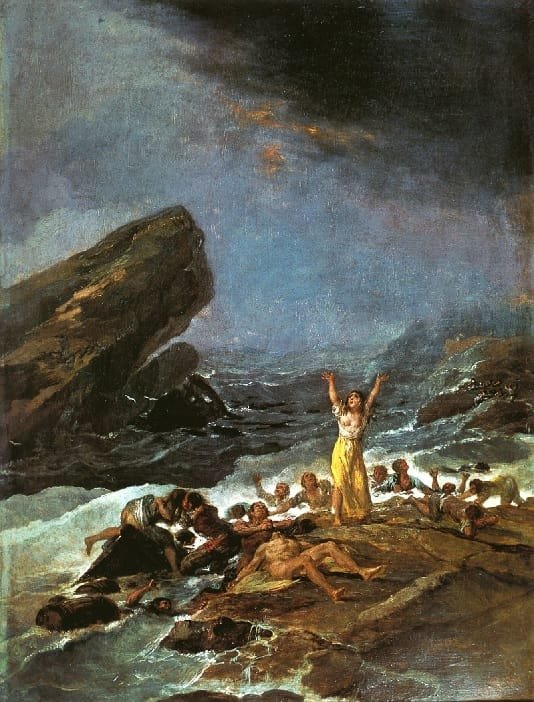Francisco De Goya is regarded as one of the most influential figures in the history of art, particularly for his oil paintings that span various themes, techniques, and emotions. His works reflect the turbulent times in which he lived, ranging from royal portraits to nightmarish visions. Known for his versatility, Goya’s oil paintings capture the essence of his subjects while simultaneously exploring deeper themes of humanity, war, and madness. His unique style and fearless approach to tackling complex subjects made him a pioneer, bridging the gap between the Old Masters and modern art.
Early Portraits: Goya’s Rise to Fame
Goya’s Early Career and Royal Patronage
Francisco De Goya’s early career was marked by his skill in portraiture, which earned him commissions from the Spanish aristocracy. His keen ability to capture the character and status of his subjects quickly gained him recognition, leading to his appointment as a court painter for King Charles IV.
Notable Portraits by Goya
- Portrait of the Duke of Wellington (1812): A striking depiction of the British military leader, showcasing Goya’s ability to capture both power and vulnerability.
- Charles IV of Spain and His Family (1801): One of his most famous royal portraits, this painting not only portrays the grandeur of the Spanish monarchy but also subtly critiques it by highlighting the awkwardness and vanity of the royal family.
Goya’s Shift in Style: The Effects of War and Illness
As Goya’s career progressed, the artist experienced a dramatic shift in both his style and subject matter. This transformation was largely influenced by his personal struggles, including a severe illness that left him deaf and the horrors of the Peninsular War (1807-1814). These events significantly impacted his worldview, which became more pessimistic and reflective in his later works.
The Peninsular War and Its Impact
Goya’s disillusionment with the brutality of war is most famously depicted in his series of etchings titled The Disasters of War. However, this period also saw the creation of some of his most powerful oil paintings, particularly those that depict the suffering and violence inflicted on civilians.
The Black Paintings: A Glimpse into Goya’s Darker Psyche
What Are the Black Paintings?
Toward the end of his life, Goya retreated into isolation, where he created a series of haunting oil paintings that are now referred to as the Black Paintings. These works, painted directly onto the walls of his home, reflect Goya’s darkest thoughts and fears. The themes in these paintings are often interpreted as expressions of Goya’s inner turmoil and skepticism toward humanity and religion.
Notable Works from the Black Paintings
- Saturn Devouring His Son (1819-1823): Perhaps the most famous of Goya’s Black Paintings, this disturbing depiction of the Greek mythological figure Saturn reflects the brutal and destructive nature of mankind.
- Witches’ Sabbath (1819-1823): This painting showcases Goya’s fascination with the supernatural and his condemnation of superstitions and religious fanaticism.
- The Dog (1819-1823): This enigmatic work, featuring a lone dog gazing upwards, is one of Goya’s most emotionally charged paintings. The minimalism and sense of isolation in the painting reflect the existential despair that permeates the Black Paintings as a whole.
Symbolism and Interpretation in Goya’s Oil Paintings
Francisco De Goya’s oil paintings are filled with symbolism and hidden meaning. His later works, in particular, are often interpreted as visual representations of his philosophical reflections on human nature, suffering, and power.
Political and Social Commentary
Throughout his career, Goya used his art as a medium for social and political critique. His portraits of the Spanish aristocracy, while often flattering, also contain subtle hints of satire. As Goya grew older, his critiques became more explicit, particularly in his depictions of the horrors of war and the irrationality of human behavior.
“The Dog” by Francisco De Goya: A Study in Despair
One of the most compelling examples of Goya’s symbolic approach to painting is “The Dog” by Francisco De Goya. The painting features a dog, barely visible against an overwhelming void, seemingly drowning in a sea of earth or sand. The composition is strikingly minimalist compared to Goya’s earlier works, yet it conveys a profound sense of isolation and helplessness. Some art historians interpret the image as a metaphor for man’s existential struggle, while others see it as a representation of Goya’s personal despair in the face of death. Regardless of interpretation, The Dog remains one of Goya’s most powerful and enigmatic works.
Goya’s Influence on Modern Art
Francisco De Goya is often considered the last of the Old Masters and the first of the modern painters. His ability to blend realism with psychological depth and emotion has influenced countless artists, from the Romantics to the Surrealists.
Artists Inspired by Goya
- Édouard Manet: Manet admired Goya’s raw, unfiltered portrayal of reality, particularly in works like The Third of May 1808.
- Pablo Picasso: Picasso drew inspiration from Goya’s bold political statements and his ability to capture the dark side of human nature, as seen in Guernica.
- Salvador Dalí: Goya’s exploration of dreams and nightmares, especially in his Black Paintings, foreshadowed the themes of Surrealism that Dalí would later explore.
Goya’s Lasting Legacy in the Art World
Francisco De Goya’s oil paintings continue to be celebrated for their technical brilliance and emotional depth. His willingness to confront uncomfortable truths about human nature, society, and war set him apart from his contemporaries. Whether through his early portraits of royalty or his haunting Black Paintings, Goya’s work remains relevant today, offering insights into the human condition and the complexities of life.
Key Themes in Goya’s Work
- Realism vs. Symbolism: Goya mastered the art of blending realistic representation with deeper symbolic meanings.
- Social Critique: Many of Goya’s paintings, particularly in his later years, serve as scathing critiques of war, superstition, and human folly.
- Emotional Depth: Goya’s ability to convey complex emotions through his paintings, from the serene to the nightmarish, ensures his place as one of the most important figures in art history.
Conclusion: The Unforgettable Genius of Francisco De Goya
Francisco De Goya’s oil paintings offer a unique window into the artist’s mind and the world around him. His ability to capture the beauty, horror, and absurdity of life through his art has made him a timeless figure in the history of painting. Goya’s works continue to resonate with audiences today, whether viewed as historical records, social critiques, or profound meditations on existence. His legacy as one of the greatest painters of all time remains secure, with his influence evident in countless works of art created long after his death.



